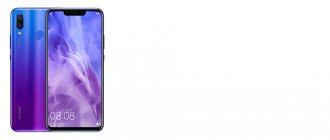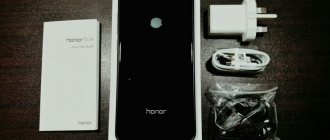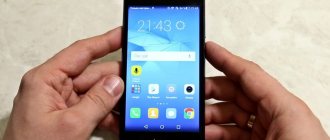How good are the cameras on the Honor 8X? The smartphone is an excellent “mid-ranger” from Huawei, equipped with a huge display and 2 main camera modules. But are they good or bad? Let's figure it out.
Go straight to:
- Camera specifications
- Photo examples
- Night photos
- Portrait mode
- Selfie examples
- Aperture mode
- Video examples
- Verdict
Camera specifications
Even though I wanted to, I couldn’t find what exact models of camera sensors are used in the Huawei Honor 8X. Apparently, this information is classified as secret, but if we take the publicly available characteristics, they look like this:
- Main camera – 20 MP, f/1.8;
- Second camera - 2 MP (for measuring depth and creating a blur effect);
- Front camera – 16 MP, f/2.0.
This is all the information that we were able to find on the Honor 8X camera modules. Also note that 20 MP is the physical resolution of the sensor and not all modes will have exactly such photos. In fact, it turns out something like this:
- Main photos in standard mode - 20 MP;
- In night mode - 8 MP;
- In large aperture simulation mode - 8 MP;
- In AI mode (artificial intelligence) - 12 MP;
- In portrait mode - 8 MP.
As for the front camera, the full resolution of the matrix is always used here.
Video recording:
- Main camera – 1080P 30FPS and 1080P 60FPS;
- Front camera – 1080P 30FPS;
- Slow Motion - 720P 120 FPS and Super Slow Mo 480FPS.
Photo examples
The photos were reduced to 5 MP and were not processed in any way.
Night and evening photos
Huawei Honor 8X has a wonderful night mode that allows you to take great photos in the dark. The automation works in such a way that it takes a series of frames with different exposures and combines them into one, thereby obtaining a very interesting result. At the same time, the photographs produce a fairly long shutter speed - 4-8 seconds and this is handheld!
The first photos were taken in HDR mode in the evening, but the rest were taken in night mode. It is easy to recognize by its contrast and bright colors; for comparison, a photo in HDR mode is also shown. Also pay attention to the last 2 pictures, they were taken in night mode, but with a tripod, with a shutter speed of 16 and 22 seconds, respectively.
Huawei Honor 8C review: autonomy
The capacity of the non-removable lithium-polymer battery in Honor 8C increased by a third compared to its predecessor and amounted to 4,000 mAh. Coupled with an energy-efficient processor, this promises good battery life. The manufacturer claims that the accumulated energy reserve in the battery is enough for two days, if you don’t get carried away with games (in general, you can count on a day and a half for sure).
Playing a test set of MP4 (hardware decoded) and HD videos at full brightness every hour reduced the battery charge by about 10% (test for 7 hours). There is no support for fast charging, and a 10-watt adapter (2 A/5 V) is included with the smartphone. To “fill” a full tank with it, you will have to spend about three hours.
Portrait mode on Honor 8X
Portraits on the Honor 8X come out well. Portrait mode works with background blur on both the main and front cameras. The only caveat is that you can adjust the aperture on the main camera later, but not on the front camera. This is understandable; this is where the second, 2 MP camera module comes into play. For example, at aperture 0.95, a portrait might look like this:
But with f/1.4 aperture
and a couple of examples with f/4
Subjectively, the quality is quite good, on par with other smartphones in this price range. Let me remind you that in portrait mode on the Honor 8X the photos are 8 megapixel.
Honor 8 review: smartphone as a camera
Mobile phones “killed” the compact camera market - now this is a fact, and not the bold invention of futurists or science fiction writers. The capabilities of the built-in camera are already sufficient to fully cover the needs of household and amateur photography. In fact, cell phone photos are regularly used in the news and even featured on magazine covers. Why, even Apple used iPhone photos in its advertising campaign.
But still, any mobile camera has many limitations. In almost all cases, we get a lens with a fixed focal length; zoom is only possible digitally, although now the problem is solved by adding a second lens, a longer one.
Attempts to “pump up” the photographic component of smartphones have been made repeatedly. You can recall smartphones with large zoom lenses (Samsung Galaxy Camera), and with a large matrix (Panasonic Lumix CM1), and other bold experiments (ASUS Zenfone Zoom), but none of them could become quite popular. The reason is trivial - such a device was bulky and became downright inconvenient as a telephone itself. Thus, manufacturers gradually came to the understanding that a phone should remain a phone, and the evolution of built-in cameras took its course.
There are many convenient smartphones with high-quality cameras, usually flagship models with impressive characteristics and exorbitant prices. But any technology inevitably becomes cheaper, and then very affordable devices appear that are equally convenient both as a phone and as a camera. Honor 8 from Huawei is one of the most interesting devices in this regard. And today we will look at it in detail.
Honor 8 as a phone
| Huawei Honor 8 | |
| operating system | Android 6.0 (Marshmallow) |
| Screen | IPS, 5.2-inch diagonal, resolution 1080×1920 pixels |
| CPU | Octa-core HiSilicon Kirin 950 (4 cores 2.3 GHz + 4 cores 1.8 GHz) + Mali-T880 MP4 graphics accelerator |
| Memory | 3/4 GB RAM, 32/64 GB storage, microSD slot (up to 256 GB) |
| Mobile/Data | GSM/GPRS/EDGE, UMTS, HDSPA/HSUPA, LTE |
| Camera | Main - dual 12 MP, autofocus, flash, front - 8 MP, without autofocus and flash |
| Interfaces | USB-C, Wi-Fi, Bluetooth 4.1, GPS/GLONASS, NFC |
| Battery | 3000 mAh, non-removable |
| Dimensions and weight | 146×71×7.5 mm, 153 g |
From the face, Honor 8 is very similar to many of its competitors, and in shape it is very similar to the 4.7-inch iPhone 6/6s. But this is a common thing - since mobile phones abandoned the hardware keyboard, they are all similar in many ways. Typically, the design is divided into models with hardware buttons placed under the screen (“Back”, “Home” and a list of open applications) and smartphones with similar keys that appear contextually on the display itself. Subjectively, this solution is more convenient than fixed keys: at least you won’t accidentally hit them, and due to the free lower part you can enlarge the screen.
A double card slot allows you to install either two nanoSIM format SIM cards, or one SIM card and one microSD card with a capacity of up to 128 GB. At the top there is an additional microphone and an infrared port. On the right side there is a volume key and a button to turn on or lock the device. At the bottom there is a 3.5 mm port, round (one-on-one, like on the iPhone, sorry) speaker slots and USB Type-C version 2.0. A surprise awaits on the back cover - two cameras instead of one. This is a relatively new trend in the industry, and so far few smartphones can boast of it: iPhone 7 Plus, Huawei Mate 9, LG G5 and several other models. We will tell you more about why this is needed later. For now, it's worth noting that just below the cameras on the back is a fingerprint scanner. You won’t immediately understand that this is not just a sensor, but also a button.
Huawei Honor 8 is available in four colors: white, black, blue and gold. We are just dealing with the gold version, and, unlike the gold iPhone, this Honor 8 looks not at all vulgar, but even beautiful. The back cover has a volume effect - it looks interesting. True, despite the use of Corning Gorilla Glass 3, scratches appear quite quickly, although no one rubbed the smartphone with sandpaper or carried it in a pocket with keys. Fingerprints are also clearly visible, but they can be easily removed.
The filling here is powerful, but still not the most sophisticated. According to processor performance tests, Honor 8 is almost on par with the Samsung Galaxy S6, a top-end device from early 2015. The internal memory can be 32 or 64 GB (depending on the specific modification), and the RAM can be 3 or 4 GB, again, depending on the specific modification. But if there is a card slot, the amount of built-in memory is not so critical.
Full HD resolution, in our opinion, is optimal with a diagonal of 5.2 inches. Individual pixels are not visible to the naked eye (density 423 ppi), and the “iron filling” copes with processing an image of this size without any problems. Separately, it is worth noting the natural color rendition of the IPS matrix. In smartphones with AMOLED displays, the palette is brighter, but sometimes it seems too variegated.
The battery, unfortunately, is non-removable, but the 3000 mAh capacity does not make you want to urgently replace the battery with a more sophisticated one. One charge is enough for the device to last from early morning until late evening. In addition, fast charging technology allows you to charge the battery halfway in just 30 minutes.
Honor 8 as a camera
As already mentioned, the smartphone has not one, but two cameras on the rear panel. Each module uses a 12-megapixel CMOS sensor and an f/2.2 aperture lens. The equivalent focal length is approximately 24mm. The flagship Huawei P9, created in close collaboration with Leica, had exactly the same camera parameters. The manufacturer does not specify what exactly this cooperation consisted of - most likely, it was about the rights to use the brand and nothing more.
Example photo in normal mode
1/50 s. ISO: 100. f/16.
Example photo with shallow depth of field effect
1/50 s. ISO: 100. f/4.
So, in Honor 8 we are dealing with Sony IMX286 modules, which have already proven themselves in other smartphones. Since no mobile camera allows you to manually set the aperture, Huawei and Leica have offered software simulation of shooting with a shallow depth of field. Actually, in Honor 8 it works in a completely similar way. To do this, you need to activate a special shooting mode (the aperture icon in the camera application), and then shoot as you are used to. By touching, you can set the area of sharp image both during shooting and in photo editing mode after shooting. The effect of maximum blurring of a picture is beautifully called F0.95, the minimum - F16. Of course, this has nothing to do with the actual aperture number of the optics.
Setting up shallow depth of field effect in Honor 8 gallery app
For simpler software manipulations with the image, one camera is pointed where you tell it, and the second shoots with maximum defocus. However, in some cases (for example, when focusing at infinity), the background is blurred using a software filter, something like an analogue of Lens Blur in Photoshop.
Examples of shots with a shallow depth of field effect
1/35 s. ISO: 320. f/4. | 1/35 s. ISO 160. f/4. |
1/50 s. ISO 125. f/4. | 1/35 s. ISO 160. f/4. |
Examples of pictures in normal mode
1/30 s. ISO 160. f/2.2. | 1/35 s. ISO 200. f/4. |
1/40 s. ISO 160. f/4. | 1/30 s. ISO 200. f/2.2. |
1/50 s. ISO 125. f/16. | 1/35 s. ISO 160. f/16. |
1/35 s. ISO 160. f/16. | 1/35 s. ISO 200. f/16. |
1/100 s. ISO 64. f/4. | 1/100 s. ISO 50. f/4. |
It is also worth noting the fast focusing by the standards of mobile cameras. The smartphone is helped in this by a built-in laser sensor, which is effective at distances of up to one meter. When shooting from longer distances, phase detection autofocus sensors located directly on the sensor help. In short, you can even shoot dynamic scenes on Honor 8. And in general, in the right hands it will perform no worse than some medium-caliber compact camera from the recent past.
What's the result?
If you need an excellent smartphone for all occasions at a price of up to 30 thousand rubles, which can also offer excellent shooting capabilities, then Honor 8 remains perhaps the only choice. An iPhone 7 Plus with a similar camera module will cost twice as much, and Chinese analogues like Xiaomi or Meizu do not inspire confidence among many, but Huawei got rid of the image of a typical Chinese manufacturer long ago and successfully.
In the price category up to 30 thousand rubles, Honor 8 has practically no competitors in terms of shooting quality. And if you compare it with flagship solutions, you can only complain about the lack of the ability to shoot in uncompressed DNG format. But this does not prevent us from calling Honor 8 one of the most successful smartphones of the outgoing year.
Selfies and portraits with the front camera
But it’s already so easy to get a clear picture with the front camera. You can see a narrower dynamic range and generally mediocre quality of the camera module itself. Here is an example of a 16 MP photo without background blur
and with blur,
in difficult conditions
Photo with background blur
Using the main camera, using the second module, you can take photos of objects and objects simulating a shallow depth of field. At the same time, the aperture can be adjusted programmatically from 0.95 to 16, both during shooting and after. Here are some examples of photos in this mode.
Practice of use
The ergonomics of Honor 8 do not raise any questions, the main buttons are accessible, and the fingerprint scanner, combined with additional functionality, is a godsend. As in the P9 series, you can scroll through photos and open the notification window; it is now possible to launch applications with a single or double press, as well as with a hold. These things may seem insignificant, but when using the same LG G5 SE, you catch yourself thinking that this is missing. The fingerprint recognition speed is high.
Synthetic tests showed high performance, somewhere even higher than P9 Plus, but during everyday use there were periodic “freezes”. Their nature is not very clear, we are not talking about some resource-intensive applications and difficult usage scenarios, it could be a banal activation of the screen, switching to other desktops, etc. At the same time, more than 2 GB of RAM was always available. This was not observed in the P9 series. Perhaps a firmware update and optimization will correct the situation, but nothing arrived during testing.
The main camera is pleasing, but a slight delay between pressing the shutter and shooting is noticeable. It’s clear that this is not a top flagship, but we wanted to get an instant reaction. The video quality could be higher; in 720p mode it looks much better than 1080p.
During testing, the glass that protects the display did not collect a single scratch, which cannot be said about the glass on the back. There are quite a few scratches on it.
Verdict
Overall, I found the Huawei Honor 8X cameras interesting. Yes, the main module is quite simple and without good software, it would be of little use. But here there is a rather interesting camera software that takes quite good pictures in the evening and at night. During the day, the photos are quite comparable with the cameras of other smartphones in this price segment, for example, with the camera of the Xiaomi Mi A2, with which there will be a full comparison.
Out of the box, the Camera 2 API is active, which means you can shoot in RAW, for example through Lightroom Mobile or OpenCamera, and also use Google Camera mods. By the way, I have already tested one of them and it works quite well, but there are some nuances.
In terms of video recording, everything is quite simple. There is no digital or optical stabilization in the smartphone, and therefore the video is of very mediocre quality, even at 1080P 30FPS. Even the H.265 codec, which is included in the stock camera application, cannot save it. A video recording mode in 1080P 60 frames per second is also available, it works quite well, and the picture turns out to be nice in color, but autofocus is a problem. In this mode, it does not want to focus normally, especially at infinity.
There is no 4K video recording here. Overall, the device is interesting, especially for its price and the cameras cannot be called its weak point, but if high-quality video recording is critically important to you, then you should take a closer look at other devices in this price range.
Where to buy a smartphone:
Huawei Honor 8X Global Version
RUB 12,929
in stock
Buy
Aliexpress.com
Display
The screen diagonal is 5.2 inches, uses an LTPS matrix with a resolution of 1920×1080 pixels (423 ppi), and is protected by 2.5D Corning Gorilla Glass 3.
The maximum measured screen brightness was 480 cd/m2. Not a bad result, but it’s not always comfortable to work in sunny weather. The minimum brightness is only 3 cd/m2, which is convenient to use at night.
With the initial settings, the display displays a temperature of 9295K, which is too high, of course. In the “Cool Colors” mode it’s 10171K, while “Warm Colors” gives a much more practical indicator – 7998K. After a series of experiments, we managed to get closer to 7600K, but failed to achieve the coveted 6500K.
The matrix covers 100% sRGB and 90% AdobeRGB. Judging by the graph, there are no questions about the blue color, but we got a little more red and a lot of green. The smartphone does not have an sRGB mode. Extended coverage means that photographs and pictures will not look entirely natural. The gamma curve is in fact standard, the gradation of tones is excellent. Color accuracy is decent, average DeltaE is within 3.77 units, peak value is 7.46.











